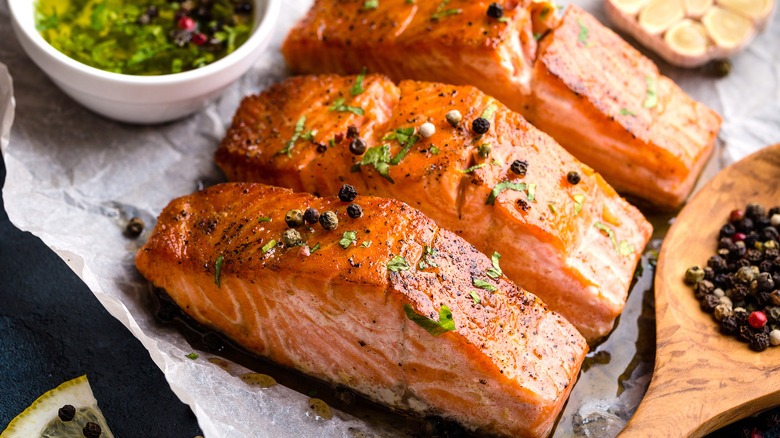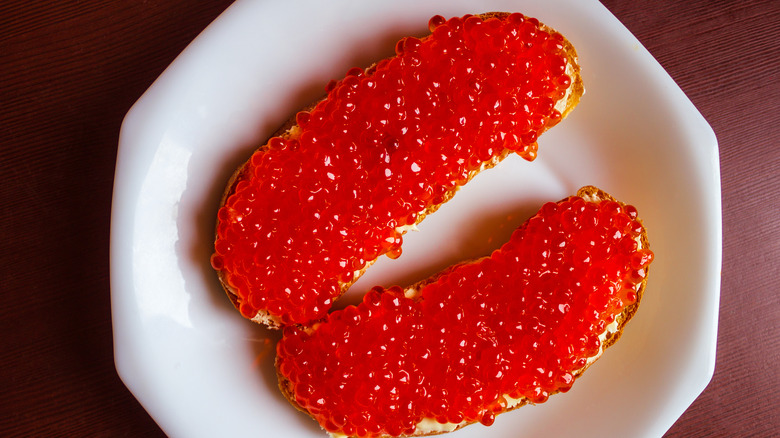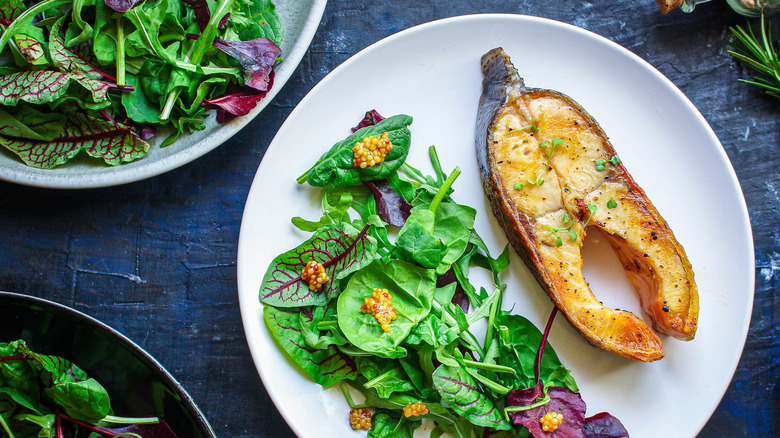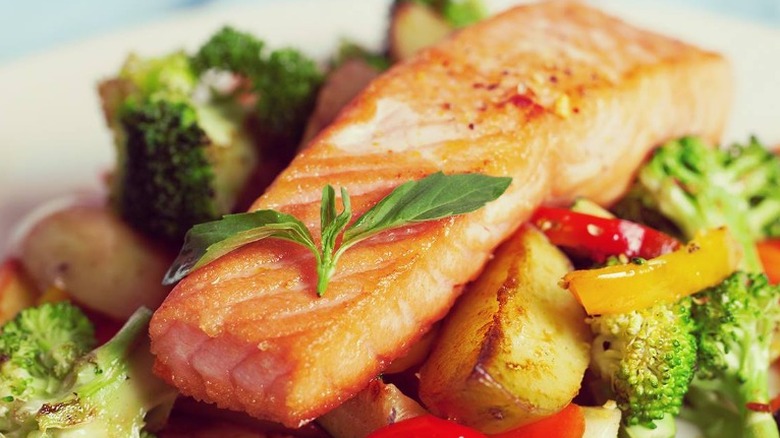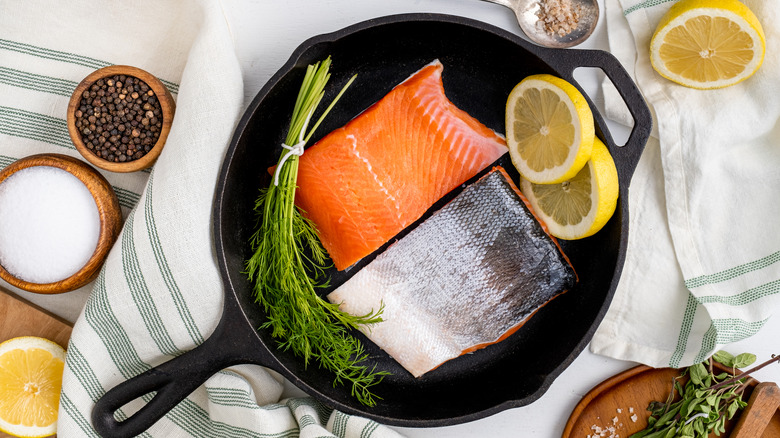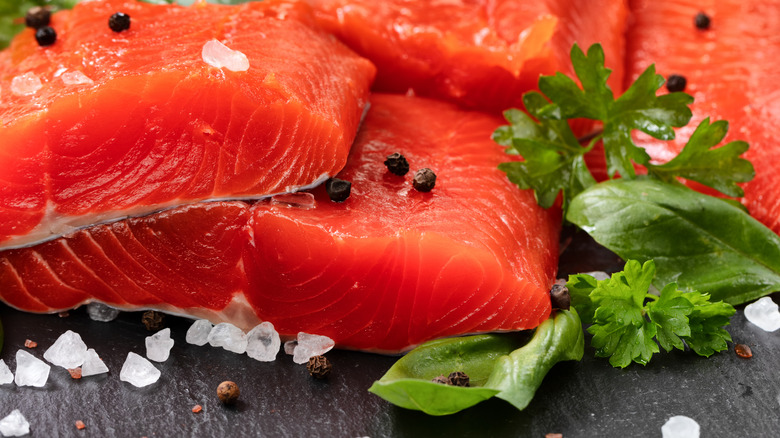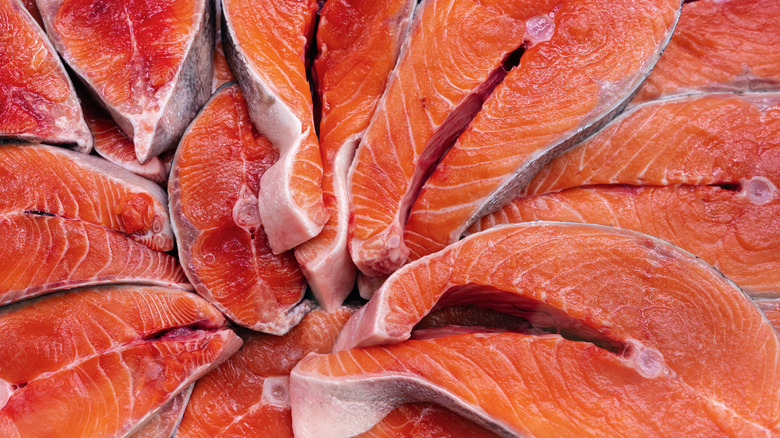6 Types Of Salmon Ranked Worst To Best
Salmon is delicious, versatile, and a much-beloved fish that delivers valuable nutritional benefits. Salmon receives praise as one of the healthiest fish on the market thanks to a high concentration of omega-3 fatty acids, which have heart-healthy benefits. Many cultures have long recognized the value of salmon. First Nation tribes of North America revere the fish and hold a yearly ceremony called the First Salmon Feast. Across the globe, the presence of salmon also has a respected role in the traditional Japanese New Year feast of Osechi Ryori, where it is considered a food of youth. What has sustained these cultures for generations continues to be a sought-after, highly-in-demand delicacy for our dinner plates.
Due to its growing popularity as a lean protein, there's now an abundance of grocery store options for purchasing and consuming salmon. However, the prominence of salmon in seafood markets can be particularly confusing and full of industry-specific terms. Is this salmon sourced sustainably? Should I buy wild-caught or farm-raised salmon? What determines high-quality salmon? All Recipes outlines a couple of essential factors to pay attention to when buying salmon, like the size of the fish, whether it contains bones, and the color of the meat. Learning where to pay attention (and a few insider terms) can lead to a more informed purchase. This will help match you with the best salmon for your intended cooking method. While everyone has different factors motivating their needs, our all-around list compares six of the most popular types of salmon on the market to show that not every species grows the same.
6. Chum Salmon
One of the least versatile, chum salmon is a Pacific variety that swims the western coast of America, weighing 8 to 15 pounds (via the National Oceanic and Atmospheric Administration). Chum is also known by many other names, such as Silverbrite, Keta, or dog salmon. As you might imagine, such a descriptive name comes from history. Chum was a typical food for dog sled teams in North America, says the Smithsonian Magazine. Also, as chum salmon age, their bodies turn brown, and their lips curl in, making them aesthetically undesirable. As a result, chum salmon have not received the same recognition as sockeye or king salmon. However, more attention is being shown to this tasty variety, despite its unfortunate appearance. While the title and look may not be immediately appetizing, chum salmon delivers incredible taste for a more affordable price.
Chef Resources says that the light pink to orange-colored flesh is drier than other types of salmon, and the mild-tasting interior of chum is best prepared via bake, broil, grill, poach or sauté. Due to being more coarse and lean, Taste of Home recommends preparing chum salmon with preservation cooking methods, like smoking, roasting, or drying into jerky. Additionally, the site says that chum salmon is often caught for its roe. According to research collected by WebMD, salmon roe has a hefty nutritional profile of protein, antioxidants, and omega-3 fatty acids.
5. Pink Salmon
According to Smithsonian Magazine, there are many types of Pacific salmon, and pink is the most common species found in bodies of water from Oregon to Alaska. Much like a chum salmon, the Alaska Department of Fish and Game writes that pink salmon lack oil content compared to more desirable fish, and are most commonly canned and preserved. Pink salmon are smaller, weighing on average 3.5 to 5 pounds per fish, and male salmon develop a distinct bump on their back, earning the nickname humpbacks, as noted by the National Oceanic and Atmospheric Administration. Another reason to consider pink salmon is the sustainable farming practices of this fish. Regulations detail that pink salmon caught in the U.S. are monitored, protected, and limited for commercial and recreational purposes through state and federal regulations.
Canned pink salmon is a lean snack — data from the U.S. Department of Agriculture shows a 3 ounce portion of pink salmon has less than one gram of saturated fat. As outlined in Taste of Home, this profile makes it ideal for topping salads, scooping from the can, or mashing pink into salmon cakes. Pink salmon is the winner if you are on the market for a healthy, sustainable, low-oil option.
4. Atlantic Salmon
While there are many types of Pacific salmon, there are only one species of Atlantic (via the National Oceanic and Atmospheric Administration). The Atlantic variety is commercially available exclusively through farm-raised production, with the average fish weighing 8 to 12 pounds. Compared to chum and pink salmon, Atlantic salmon has higher oil content, a light pink-to-orange colored flesh, and a flakey, dense texture, as outlined in Chef Resources.
In the past, farm-raised seafood conjured up images of dense areas, over-crowded fish, and pollution within the body of water and surrounding environment. There have been decades of significant developments in sustainable farm fishing. However, as National Geographic details, it's still important to understand industrial terminology such as wild-caught, farm-raised, and sustainably farm-raised when looking at labels for salmon.
As identified, wild-caught means fish have been captured by fishing vessels from their natural habitat. On the other hand, farm-raised salmon use net pens where fish are fed, and a flow of water moves throughout the farm. This practice may sound cleaner, but it can also mean chemicals, waste, and feed can stream freely into the natural environment. Sustainable farm-raised salmon varies because it considers the surrounding environment and ecosystem — salmon are raised in aquaculture tanks where fish farmers can filter water and properly dispose of contaminants to local marine biomes. Now the most available option at the grocery store, be sure to check how your Atlantic salmon is raised.
3. Coho Salmon
Moving into the next tier of quality, Coho salmon (also called silver salmon) have less oil content than sockeye or king salmon but are still a much-beloved type of Pacific salmon (via Fishchoice). On average, Coho salmon weigh 7 to 8 pounds, have nearly double the oil of pink and chum salmon, and when cooking, their interior reveals vibrantly reddish-orange meat, writes Fishchoice. In terms of price, quality, and fat content, Coho swims squarely into the middle of this list. This type of salmon is an excellent option for recipes that involve poaching, smoking, cooking en papillote, or other low-heat slow-cooking forms.
Information presented by the California Department of Fish and Wildlife shows that due to overfishing and habitat loss, some northwestern Coho runs have been on the endangered species watchlist since 1996. Further reporting from the Guardian suggests that extreme drought in the region has made it hard for Coho populations to respawn in former territories.
Though Coho salmon are indigenous species to the Pacific coast of North America, they were introduced to The Great Lakes in 1967, according to the Michigan Department of Natural Resources. While there are many myths surrounding salmon and salmon production, the reality is that this is one of the most eaten fish in the world. Creative solutions, like introducing salmon to new bodies of water, help alleviate pressure on wild stocks and protect salmon populations from extinction — necessary steps to control the effects of climate change on the U.S. food supply.
2. Sockeye Salmon
The Wild Salmon Center writes that sockeye salmon are more commonly referred to as red salmon due to their deeply colored body, which results from a diet high in krill. This fish is a Pacific variety primarily found on the coast of Alaska, Washington, and Oregon. According to the National Oceanic and Atmospheric Administration, sockeye salmon is one of the best-protected species with tight fishing regulations and stock monitoring. The result has kept hundreds of healthy stocks in Alaska, despite strict listings as threatened or endangered for other West Coast populations.
Second, only to King salmon in fat content, sockeye is full of omega-3 fatty acids, low in sodium, and rich with a distinct salmon flavor, writes Fishwatch. With a diet high in crustaceans and plankton, the characteristic dark red tint of sockeye salmon flesh has a firm, dense texture. Sockeye salmon are smaller than other Pacific varieties, with NOAA data weighing the average sockeye between 4 to 15 pounds per fish. Nearly all cooking methods used to prepare sockeye will result in a delicious meal, but some techniques let the flavor of the fish shine more than others. According to Chef Resources, raw, high-grade sockeye salmon is commonly used in Japanese sushi dishes, such as handrolls or sashimi, because of the eye-popping color and richly flavorful meat. Even though fillets can be thinner, grilled salmon is another recipe to try with sockeye.
1. King Salmon
King salmon lives up to its name as the premier salmon in size and taste. Chef Resources says that king salmon, otherwise known as Chinook salmon, is the largest salmon in the Pacific, with an average weight of 20 pounds and a potential weight of over 50 pounds. Due to overfishing and habitat loss, different runs of king salmon have rotated onto the federal list for threatened or endangered species. The Environmental Protection Agency identifies Puget Sound Chinook as the first federally protected stock, having joined the list in 1999.
A study in the Journal of Agriculture and Food Research shows fillets of wild-caught Chinook have the highest fat content, which adds to the succulent texture of the sharp, internal color. These taste factors might explain the cost of king salmon; According to All Recipes, king salmon is consistently the most expensive type on the market. The combination of meaty mouthfeel and silky consistency makes up for the price. You might expect Chinook to be delicate, but as The Spruce Eats details, the unique characteristics of king salmon make it an adaptable fish to various tough cooking methods, including charcoal grilling. Using this process, king salmon can achieve a buttery interior with a crispy surface, allowing the characteristic flavors to play the lead role.
